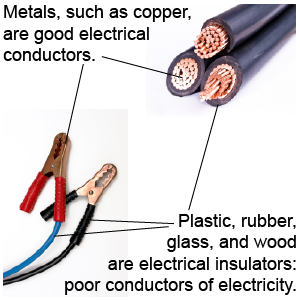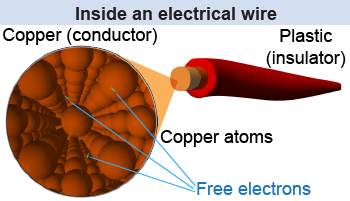|
 Based on their electrical properties, materials can be divided roughly into conductors and insulators. A metal such as copper is commonly used as an electrical conductor because it offers little resistance. For example, 1 m of 20-gauge copper wire has a resistance of 0.03 Ω. At the other end of the scale, a material with high resistance is classified as an electrical insulator. Even a thin layer of plastic can have a resistance of 1,000,000 Ω or more. Electrical devices and wires are typically covered by an insulator, such as plastic. Other good insulating materials include glass and wood.
Based on their electrical properties, materials can be divided roughly into conductors and insulators. A metal such as copper is commonly used as an electrical conductor because it offers little resistance. For example, 1 m of 20-gauge copper wire has a resistance of 0.03 Ω. At the other end of the scale, a material with high resistance is classified as an electrical insulator. Even a thin layer of plastic can have a resistance of 1,000,000 Ω or more. Electrical devices and wires are typically covered by an insulator, such as plastic. Other good insulating materials include glass and wood. 
 |
Silicon and germanium belong to a small group of materials called semiconductors that have conducting properties intermediate between conductors and insulators. Some of the electrical properties of semiconductors are a consequence of quantum physics. You will learn more about semiconductors on page 687 in Chapter 23. 
|
 In metals such as copper, the outermost electrons are not bound to a single atom, so they can flow and make electric current. These free electrons are what make copper a good electrical conductor. When there is a voltage across a conductor, electrons are attracted to the positive terminal and repelled from the negative terminal. The voltage provides a force that moves the electrons to create the electric current. The higher the voltage, the faster the electrons move, and the more power is transferred by the moving electrons to devices that can use the power, such as electric motors.
In metals such as copper, the outermost electrons are not bound to a single atom, so they can flow and make electric current. These free electrons are what make copper a good electrical conductor. When there is a voltage across a conductor, electrons are attracted to the positive terminal and repelled from the negative terminal. The voltage provides a force that moves the electrons to create the electric current. The higher the voltage, the faster the electrons move, and the more power is transferred by the moving electrons to devices that can use the power, such as electric motors. 
 |
Superconductors are a fascinating exception to the rule that current only flows when there is a voltage difference. A superconductor is a special kind of material that can continue to carry an electrical current even after the voltage has been removed. In fact, a loop of superconducting wire could theoretically carry a current forever once the current was started. Today, superconductors only operate at temperatures far too low for everyday use, but developing “room-temperature” superconductors is an active area of both physics and engineering research. If developed, a practical superconductor would revolutionize our electrical technology. 
|
The resistance of metals increases somewhat as their temperature increases. As a result, some electrical circuits might only function properly over a limited range in temperature. Other circuit parts, particularly transistors, also can fail at extreme temperatures. Many electrical devices, such as computers, have cooling fans built into their housing to prevent overheating of the components. 
|
Touching a 120 V wall outlet is dangerous. Electric current flowing through the body causes electric shock that can kill a person. A typical range for the body’s resistance is 300–1,000 Ω—although it can be as high as 100,000 Ω if your skin is dry or only 100 Ω if you are soaked in saltwater. Currents through the body of 1 mA can be felt, while currents of 10 mA and higher can cause pain and muscle spasms. 
|
Although the resistance of conductors is small, over a very long wire the resistance can add up. Wires with a large diameter—or small gauge—have less resistance than narrow wires. Home wiring typically uses a 12-gauge wire, which has a diameter of 2.05 mm and a resistance of 0.005 Ω per meter of wire. Electronic circuits often use 22-gauge wire, which has a diameter of 0.64 mm and a resistance of 0.053 Ω per meter of wire. High-voltage power transmission lines might have a diameter of between 4 and 25 mm. 
|
The resistivity ρ of a material is an indicator of its resistance. Metals with higher values of resistivity have a higher resistance per meter of wire. Copper has a resistivity of ρ = 1.68×10−8 Ω m, respectively. Semiconductors have resistivities of around 10−4 to 10−1 Ω m, whereas insulators have resistivities of around 109 to 1015 Ω m.
 |
The resistance of a conducting wire can be calculated from its cross-sectional area A, length L, and resistivity ρ from the equation | | | R | = | resistance (Ω) | | ρ | = | resistivity (Ω m) | | L | = | length of wire (m) | | A | = | cross-sectional area of wire (m2) |
| Resistivity and resistance
|

|
Which of the following materials has the highest resistance (is the best insulator)? - water
- copper
- gold
- air
 |
The answer is d, air. Air is one of the best insulators. This is why we don’t get shocked by any electric device we turn on; the air keeps the current flowing through the wires instead of jumping out. 
|

